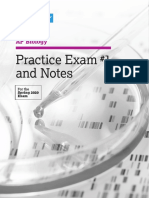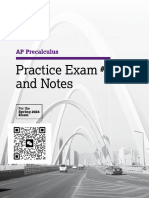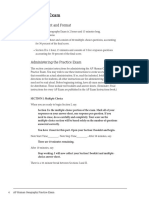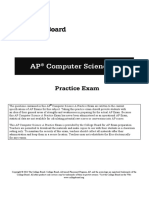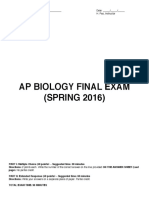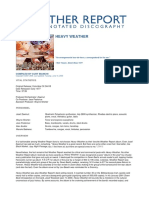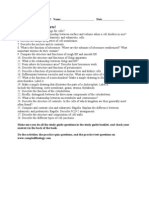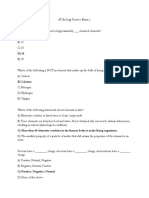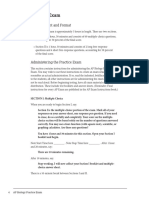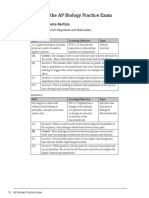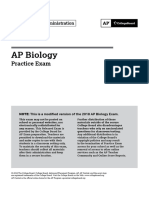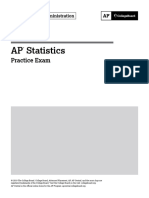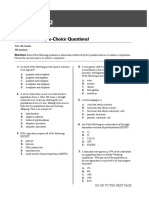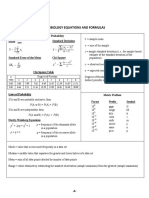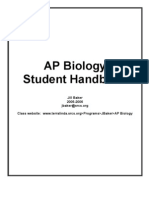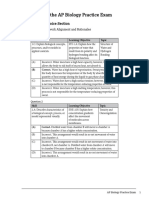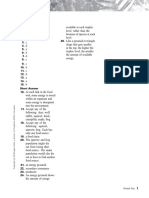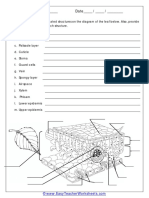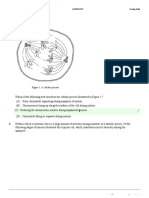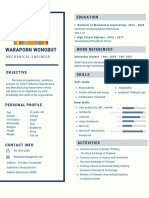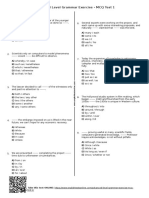Professional Documents
Culture Documents
Exam 2020
Exam 2020
Uploaded by
Sameh NoorOriginal Title
Copyright
Available Formats
Share this document
Did you find this document useful?
Is this content inappropriate?
Report this DocumentCopyright:
Available Formats
Exam 2020
Exam 2020
Uploaded by
Sameh NoorCopyright:
Available Formats
Practice Exam
Exam Content and Format
The AP Biology Exam is approximately 3 hours in length. There are two sections.
• Section I is 1 hour, 30 minutes and consists of 60 multiple-choice questions,
accounting for 50 percent of the final score.
• Section II is 1 hour, 30 minutes and consists of 2 long free-response
questions and 4 short free-response questions, accounting for 50 percent
of the final score.
Administering the Practice Exam
This section contains instructions for administering the AP Biology Practice
Exam. You may wish to use these instructions to create an exam situation that
resembles an actual administration. If so, read the indented, boldface directions
to the students; all other instructions are for administering the exam and need
not be read aloud. Before beginning testing, have all exam materials ready for
distribution. These include test booklets and answer sheets. (Reminder: Final
instructions for every AP Exam are published in the AP Exam Instructions book.)
SECTION I: Multiple Choice
When you are ready to begin Section I, say:
Section I is the multiple-choice portion of the exam. Mark all of your
responses on your answer sheet, one response per question. If you need
to erase, do so carefully and completely. Your score on the multiple-
choice section will be based solely on the number of questions answered
correctly. You may use a four-function (with square root), scientific, or
graphing calculator. Are there any questions?
You have 1 hour and 30 minutes for this section. Open your Section I
booklet and begin.
Note Start Time here ________ . Note Stop Time here ________ . After 1 hour
and 20 minutes, say:
There are 10 minutes remaining.
After 10 minutes, say:
Stop working. I will now collect your Section I booklet and multiple-
choice answer sheet.
There is a 10-minute break between Sections I and II.
4 AP Biology Practice Exam
Name:
AP® Biology
Answer Sheet
for Multiple-Choice Section
No. Answer No. Answer
1 31
2 32
3 33
4 34
5 35
6 36
7 37
8 38
9 39
10 40
11 41
12 42
13 43
14 44
15 45
16 46
17 47
18 48
19 49
20 50
21 51
22 52
23 53
24 54
25 55
26 56
27 57
28 58
29 59
30 60
6 AP Biology Practice Exam
AP Biology Exam
®
SECTION I: Multiple Choice
DO NOT OPEN THIS BOOKLET UNTIL YOU ARE TOLD TO DO SO.
Instructions
At a Glance
Section I of this exam contains 60 multiple-choice questions. Indicate all of your answers
Total Time to the Section I questions on the answer sheet. No credit will be given for anything written
1 hour and 30 minutes in this exam booklet, but you may use the booklet for notes or scratch work.
Number of Questions
60 Use your time effectively, working as quickly as you can without losing accuracy. Do not
Percent of Total Score spend too much time on any one question. Go on to other questions and come back to
50% the ones you have not answered if you have time. It is not expected that everyone will
Writing Instrument know the answers to all of the multiple-choice questions.
Pencil required
Electronic Device Your total score on Section I is based only on the number of questions answered correctly.
Calculator allowed Points are not deducted for incorrect answers or unanswered questions.
AP Biology Practice Exam 7
AP® BIOLOGY EQUATIONS AND FORMULAS
Statistical Analysis and Probability
Mean Standard Deviation x = sample mean
n 2
1 Â (xi - x ) n = sample size
nÂ
x = xi s =
i=1 n -1
s = sample standard deviation (i.e., the sample-based
Standard Error of the Mean Chi-Square estimate of the standard deviation of the
population)
SE x =
s o e 2
n 2 e o = observed results
Chi-Square Table e = expected results
p Degrees of Freedom
value = sum of all
1 2 3 4 5 6 7 8
0.05 3.84 5.99 7.81 9.49 11.07 12.59 14.07 15.51
Degrees of freedom are equal to the number of
0.01 6.63 9.21 11.34 13.28 15.09 16.81 18.48 20.09 distinct possible outcomes minus one.
Laws of Probability Metric Prefixes
If A and B are mutually exclusive, then:
Factor Prefix Symbol
P(A or B) = P(A) + P(B)
10 9 giga G
If A and B are independent, then: 10 6 mega M
P(A and B) = P(A) P(B) 10 3 kilo k
10 – 1 deci d
Hardy-Weinberg Equations
10 – 2 centi c
p2 + 2pq + q2 = 1 p = frequency of allele 1 in a
10 – 3 milli m
population
p+q=1 10 – 6 micro μ
q = frequency of allele 2 in a 10 – 9 nano n
population 10 – 12 pico p
Mode = value that occurs most frequently in a data set
Median = middle value that separates the greater and lesser halves of a data set
Mean = sum of all data points divided by number of data points
Range = value obtained by subtracting the smallest observation (sample minimum) from the greatest (sample maximum)
8 AP Biology Practice Exam
Rate and Growth Water Potential ( Y )
Rate dY = amount of change Y = Y P + YS
dY dt = change in time
dt YP = pressure potential
B = birth rate
Population Growth
D = death rate YS = solute potential
dN
= B-D N = population size
dt The water potential will be equal to the
Exponential Growth K = carrying capacity solute potential of a solution in an open
container because the pressure potential of
rmax = maximum per capita
dN the solution in an open container is zero.
= rmax N growth rate of population
dt
The Solute Potential of a Solution
Logistic Growth
( )
YS = -iCRT
dN K-N
= rmax N
dt K i = ionization constant (1.0 for sucrose
because sucrose does not ionize in
Simpson’s Diversity Index water)
( )
2
n C = molar concentration
Diversity Index = 1 - Â
N
R = pressure constant
݊ ൌ total number of organisms of a particular species
( R = 0.0831 liter bars/mole K)
ܰ ൌ total number of organisms of all species T = temperature in Kelvin (ºC + 273)
pH = – log[H+]
Surface Area and Volume
Surface Area of a Sphere Volume of a Sphere r = radius
SA 4 r 2 4
V r3 l = length
3
Surface Area of a Rectangular Volume of a Rectangular Solid h = height
Solid V lwh
w = width
SA 2lh 2lw 2wh
Volume of a Cylinder s = length of one
Surface Area of a Cylinder V r 2h side of a
SA 2 rh 2 r 2 cube
Volume of a Cube SA = surface area
Surface Area of a Cube V s3
SA 6s 2 V = volume
AP Biology Practice Exam 9
BIOLOGY
SECTION I
Time—1 hour and 30 minutes
60 Questions
Directions: Each of the questions or incomplete statements below is followed by four suggested answers or
completions. Select the one that is best in each case and then enter the letter in the corresponding space on the
answer sheet.
1. Which of the following best describes the
hydrolysis of carbohydrates?
(A) The removal of a water molecule breaks a
covalent bond between sugar monomers.
(B) The removal of a water molecule forms a
covalent bond between sugar monomers.
(C) The addition of a water molecule breaks a
covalent bond between sugar monomers.
(D) The addition of a water molecule forms a
covalent bond between sugar monomers.
2. Which of the following best describes a
characteristic of DNA that makes it useful as
hereditary material?
(A) There are many different types of Figure 1. Pedigree of an inherited trait
nucleotide bases that can be incorporated
into DNA. 3. Based on the pedigree in Figure 1, which of the
following best explains the observed pattern of
(B) The nucleotide bases can also be used to
inheritance?
provide the energy needed for
reproduction.
(A) The trait is autosomal dominant, because
(C) Nucleotide bases can be randomly replaced the cross between individuals I-3 and I-4
with different nucleotide bases to increase produced an affected offspring.
variation.
(B) The trait is autosomal recessive, because
(D) Nucleotide bases in one strand can only be
the cross between individuals I-1 and I-2
paired with specific bases in the other
produced an affected offspring.
strand.
(C) The trait is sex-linked dominant, because
the cross between individuals II-5 and
II-6 produced an affected male.
(D) The trait is sex-linked recessive, because
the cross between individuals II-2 and
II-3 produced an affected female.
GO ON TO THE NEXT PAGE.
10 AP Biology Practice Exam
Questions 4 - 8
To investigate bacterial metabolism, a researcher divided a population (culture) of Staphylococcus capitis bacteria
into two sets of culture tubes containing glucose. The researcher added a chemical to one set of tubes and measured
the pH of the cultures at 5-minute intervals as the bacteria metabolized the glucose into lactic acid. The data are
shown in Table 1.
TABLE 1. AVERAGE CHANGE IN pH IN CONTROL AND TREATMENT GROUPS OVER A 40-MINUTE
PERIOD
Average pH of Control Average pH of Treatment
Time (min) (± 2 SE x ) (± 2 SE x )
0 8.04 ± 0.05 8.04 ± 0.06
5 7.96 ± 0.03 7.91 ± 0.04
10 7.88 ± 0.02 7.85 ± 0.04
15 7.82 ± 0.02 7.79 ± 0.06
20 7.76 ± 0.03 7.70 ± 0.04
25 7.71 ± 0.04 7.67 ± 0.02
30 7.63 ± 0.03 7.63 ± 0.02
35 7.65 ± 0.02 7.60 ± 0.02
40 7.65 ± 0.01 7.59 ± 0.02
4. Which of the following best describes the 5. Which of the following was the dependent
process by which the bacteria are breaking down variable in the researcher’s experiment?
the glucose to produce lactic acid?
(A) Time
(A) The bacteria are breaking down sugars in (B) pH
the absence of oxygen.
(C) Glucose concentration
(B) The bacteria are creating a H + gradient to (D) Lactic acid concentration
synthesize more ATP.
(C) The bacteria are using their mitochondria
to break down glucose in the presence of
oxygen.
(D) The bacteria are producing CO 2 in the
Krebs cycle that is then converted into
lactic acid.
GO ON TO THE NEXT PAGE.
AP Biology Practice Exam 11
6. Which of the following graphs best represents the data in Table 1 ?
(A)
(B)
(C)
(D)
GO ON TO THE NEXT PAGE.
12 AP Biology Practice Exam
7. Based on the data in Table 1, which of the 9. A mutation in the gene coding for a
following is the earliest time point at which single-polypeptide enzyme results in the
there is a statistical difference in average pH substitution of the amino acid serine, which has
between the control and treatment groups? a polar R group, by the amino acid
phenylalanine, which has a nonpolar R group.
(A) 5 minutes When researchers test the catalysis of the normal
enzyme and the mutated enzyme, they find that
(B) 15 minutes the mutated enzyme has much lower activity
(C) 20 minutes than the normal enzyme does.
(D) 35 minutes Which of the following most likely explains how
the amino acid substitution has resulted in
decreased catalytic activity by the mutated
8. According to the data, which of the following enzyme?
best explains the results of the experiment?
(A) The substitution decreased the mass of the
(A) The pH of the treatment culture was lower enzyme so that the mutated enzyme binds
than the pH of the control because the more weakly to the substrate than the
chemical increased the bacterial normal enzyme does.
metabolic rate. (B) The substitution altered the secondary and
(B) The pH of the treatment culture was tertiary structure of the enzyme so that
higher than the pH of the control because the mutated enzyme folds into a different
the chemical denatured bacterial enzymes shape than the normal enzyme does.
and decreased the metabolic rate. (C) The substitution caused many copies of the
(C) The chemical increased the metabolic rate mutated enzyme to cluster together and
of the bacteria because it lowered the pH . compete for substrate to bind.
(D) The chemical decreased the metabolic rate (D) The substitution caused the directionality
of the bacteria because it bound all of the enzyme to change such that the
available oxygen. amino terminus of the normal enzyme has
become the carboxy terminus of the
mutated enzyme.
GO ON TO THE NEXT PAGE.
AP Biology Practice Exam 13
10. Pitcher plants are carnivorous plants that grow in 11. A particular genetic disorder is associated with a
areas where the soil contains low levels of key single gene with two alleles. Individuals with
nutrients such as nitrogen. To obtain these
two recessive alleles are affected. The
nutrients, most pitcher plants capture prey using
traps containing a digestive fluid. The captured prevalence of the disorder is 1 in 6,600 .
prey are then broken down and digested, and the Assuming the population is in Hardy-Weinberg
pitcher plant absorbs the nutrients. equilibrium, which of the following is closest to
the frequency of carriers in the general
The traps of one species of pitcher plant, population?
Nepenthes hemsleyana, do not contain digestive
fluid. Instead they provide a suitable place for
(A) 0.00015
woolly bats (Kerivoula hardwickii) to sleep.
The feces from the bat are released into the trap (B) 0.01230
where nutrients in the feces are absorbed and (C) 0.02430
provide the plant with the nitrogen it needs.
(D) 0.98770
Which of the following best describes the
relationship between the pitcher plant and the
woolly bat?
(A) The relationship is an example of
parasitism because the bat is harmed
while the plant benefits.
(B) The relationship is an example of
mutualism because both the plant and the
bat benefit.
(C) The relationship is an example of
commensalism because the plant benefits
but the bat is unaffected.
(D) The relationship is an example of
commensalism because the plant is
unaffected while the bat benefits.
GO ON TO THE NEXT PAGE.
14 AP Biology Practice Exam
Figure 1. A signaling cascade triggers the relaxation of smooth muscle cells.
12. Blood vessels are surrounded by cells called smooth muscle cells. Nitric oxide triggers a signaling cascade in
smooth muscle cells that causes the cells to relax (Figure 1).
Which of the following is represented by the gradual increase in thickness of the arrows from the top to the
bottom of Figure 1 ?
(A) The rate at which nitric oxide triggers signaling gradually increases over time.
(B) The number of signaling molecules that are produced or activated increases with each step in the pathway.
(C) The size of the proteins in the pathway increases as the signaling cascade moves through the cell.
(D) The signaling pathway uses an increase in negative feedback to reduce intracellular Ca2+ levels and cell
sensitivity to Ca2+ .
GO ON TO THE NEXT PAGE.
AP Biology Practice Exam 15
Questions 13 - 18
A student peeled the skins from grapes, exposing cells with membranes that are only permeable to water and small
diffusible solutes. The student measured the mass of the peeled grapes. The student then placed each peeled grape
into one of five solutions. After 24 hours, the student removed the peeled grapes from the solutions, measured their
final mass, and calculated the percent change in mass (Table 1).
TABLE 1. PERCENT CHANGE IN MASS OF PEELED GRAPES IN SOLUTIONS
Concentration of Solution Percent Change in Mass
Solution
(weight/volume)
Distilled water 0% 13.48%
NaCl 20% −23.39%
Tap water 0.8% 9.46%
Grape juice 2.1% 2.8%
Grape soda 13% −15.00%
In a second experiment (Table 2), the student placed a peeled grape into a solution containing both small diffusible
solutes and solutes to which the membrane is impermeable (nondiffusible solutes).
TABLE 2. CONCENTRATION OF SOLUTES IN SECOND EXPERIMENT
Concentration of Small Concentration of
Standort
Diffusible Solutes Nondiffusible Solutes
Inside grape 0.4 M 1.2 M
In solution 1.6 M 0.8 M
GO ON TO THE NEXT PAGE.
16 AP Biology Practice Exam
13. Based on Table 1, which of the following best 16. Assuming a negligible pressure potential, which
explains the difference in water potential of the following best predicts the net movement
between certain solutions and the grapes? of the small diffusible solutes and water in the
second experiment (Table 2) ?
(A) NaCl and tap water have a lower water
potential because these two solutions (A) Small diffusible solutes will diffuse into
caused the grape to gain water. the grape cells, followed by water.
(B) Grape soda and NaCl have a lower water (B) Small diffusible solutes will diffuse out of
potential because these two solutions the grape cells and water will diffuse into
caused the grape to lose water. the cells.
(C) Tap water and grape juice have a lower (C) Small diffusible solutes will diffuse out of
water potential because these two the grape cells, followed by water.
solutions caused the grape to lose water. (D) Small diffusible solutes will diffuse into
(D) Grape soda and grape juice have a lower the grape cells and water will diffuse out
water potential because these two of the cells.
solutions caused the grape to gain water.
17. Mercurial sulfhydryl is an inhibitor of
14. Based on Table 1, which of the following aquaporins. Which of the following is the most
percentages is closest to the solute concentration likely effect of adding mercurial sulfhydryl to
of the grape? the distilled water solution?
(A) 0.0% (A) The grape cells will burst because of
excess water entering by active transport.
(B) 1.3%
(B) The grape cells will gain more water
(C) 5.5% because of the activation of the transport
(D) 10.1% protein.
(C) The grape cells will shrink because active
15. A student hypothesizes that the solute transport has been inhibited.
concentration of grape juice is higher than the (D) The grape cells will gain water more
solute concentration of the actual grape because slowly because of a lack of facilitated
the grape juice has added sugar. diffusion.
Based on the data in Table 1, which of the
following best evaluates the student’s
hypothesis?
(A) The hypothesis is supported because the
mass of the grape decreased in the grape
juice.
(B) The hypothesis is supported because the
grape juice has a greater solute potential
than the grape has.
(C) The hypothesis is not supported because
the grape was isotonic to the grape juice.
(D) The hypothesis is not supported because
the mass of the grape increased in the
grape juice.
GO ON TO THE NEXT PAGE.
AP Biology Practice Exam 17
18. Which of the following best explains why larger
grapes have a different rate of water absorption
per gram of mass than smaller grapes do?
(A) The rate is slower because smaller grapes
have a larger surface-area-to-volume ratio
than the larger grapes do.
(B) The rate is slower because larger grapes
have a larger surface-area-to-volume
ratio than the smaller grapes do.
(C) The rate is slower because smaller grapes
can expand more than larger grapes to
hold excess water. Figure 1. Change in the relative concentration of
(D) The rate is slower because larger grapes product over time
have more volume to hold excess water
than smaller grapes do. 20. Figure 1 shows the amount of product produced
in an enzyme-catalyzed reaction over five
minutes. Which of the following best explains
how the rate of the reaction changes over time?
(A) The rate increases because more products
19. Which of the following best explains how some are made over time.
cells of an individual produce and secrete a (B) The rate increases because the ratio of
specific enzyme, but other cells of the same product to substrate increases.
individual do not?
(C) The rate decreases because the ratio of
(A) The cells contain different genes and product to substrate increases.
therefore do not make the same proteins. (D) The rate decreases because the enzyme is
(B) The cells have evolved under different used up as the reaction progresses.
selective pressures, resulting in some cells
making proteins that others cannot.
(C) The cells transcribe and translate different
combinations of genes, leading to the
production of different sets of proteins.
(D) The cells produce different types of
ribosomes that enable the translation of
different genes.
GO ON TO THE NEXT PAGE.
18 AP Biology Practice Exam
21. Pyruvate kinase, a key enzyme in the glycolysis 22. Different species of bumblebee compete for
pathway, is inhibited by the amino acid alanine. flower nectar in their ecosystem. While the
The ability of alanine to inhibit the enzyme is flowers vary in the length of their petals,
not affected by increasing the concentration of bumblebees vary in the length of a mouth part
substrate. called a proboscis. Bumblebees demonstrate a
preference for flowers that correspond to the
Which of the following best explains the length of their proboscis. Species with
mechanism by which alanine inhibits pyruvate proboscises of similar length tend to occupy
kinase activity? different areas. Species that live in the same area
tend to have proboscises of different lengths.
(A) Alanine binds to an allosteric site of the
enzyme, changing the shape of the Which of the following best explains the
enzyme’s active site. relationship between the different bumblebee
(B) Alanine increases the enzyme-substrate species living in the same area?
binding until the enzyme becomes
saturated. (A) The bumblebees have undergone allopatric
speciation due to geographic isolation.
(C) Alanine is a competitive inhibitor that
reversibly binds to the active site of the (B) The bumblebees have undergone niche
enzyme. partitioning due to competition.
(D) Alanine binds to the substrate, preventing (C) The bumblebees have a mutualistic
the substrate from being able to bind to relationship with other bumblebee species
the active site of the enzyme. due to natural selection.
(D) The bumblebees have a commensalistic
relationship due to the variety of niches
that are available.
GO ON TO THE NEXT PAGE.
AP Biology Practice Exam 19
23. Researchers investigated whether time of day affects the rate at which certain mRNAs produced by plants are
broken down. At either 1 hour after the start of the light period (morning) or 8 hours after the start of the light
period (afternoon), the researchers treated identical plant seedlings with a compound that blocks transcription
(time = 0 min). The researchers measured the percent remaining of two mRNAs, mRNA G and mRNA H,
over the course of 120 minutes. The data are shown in Figure 1.
Figure 1. Degradation of mRNA G and mRNA H over time after exposure to light for 1 hour (morning) or 8
hours (afternoon)
Based on the data, which of the following best describes the relationship between light and the degradation of
mRNA G and mRNA H ?
(A) Exposure to light causes the degradation of both mRNA G and mRNA H.
(B) mRNA G and mRNA H degrade at the same rate during morning exposure to light.
(C) A longer exposure to light increases the rate of mRNA G degradation but not of mRNA H degradation.
(D) Exposure to more-intense afternoon light causes both mRNA G and mRNA H to degrade more rapidly
in the afternoon than in the morning.
24. Which of the following observations would
provide the strongest evidence that two plants
belong to different biological species?
(A) There are variations in their RNA
sequences.
(B) The leaves and flowers show
morphological differences.
(C) They produce viable but sterile offspring.
(D) They occupy unique habitats in an
ecosystem.
GO ON TO THE NEXT PAGE.
20 AP Biology Practice Exam
Questions 25 - 29
Figure 1. Pathway activated by insulin binding to the insulin receptor
Figure 2: Blood insulin levels in normal mice and Esp mutant mice after exposure to glucose
Hormones are chemical signals that are released by cells in one part of the body that travel through the bloodstream to
signal cells in another part of the body. Insulin is a hormone that is released by the pancreas that induces the uptake of
glucose molecules from the bloodstream into cells. In this way, insulin lowers the overall blood glucose levels of the
body. Osteoblasts and osteoclasts are two types of bone cells that play a role in regulating blood glucose levels
(Figure 1).
Binding of insulin to the insulin receptor on osteoblasts activates a signaling pathway that results in osteoblasts
releasing a molecule, OPG, that binds to neighboring osteoclasts. In response, the osteoclasts release protons (H + ) and
GO ON TO THE NEXT PAGE.
AP Biology Practice Exam 21
create an area of lower pH outside the cell. This low pH activates osteocalcin, a protein secreted in an inactive form by
osteoblasts.
The Esp gene encodes a protein that alters the structure of the insulin receptor on osteoblasts and interferes with the
binding of insulin to the receptor. A researcher created a group of osteoblasts with an Esp mutation that prevented the
production of a functional Esp product (mutant). The researcher then exposed the mutant strain and a normal strain
that expresses Esp to glucose and compared the levels of insulin in the blood near the osteoblasts (Figure 2).
25. Based on the information provided, which of the 27. Which of the following claims is most consistent
following best justifies the claim that osteocalcin with the data shown in Figure 2 ?
is a hormone?
(A) Esp expression is necessary to prevent the
(A) The phosphorylation of the insulin receptor overproduction of insulin.
causes a response in osteoblast bone cells. (B) Esp protein does not regulate blood-sugar
(B) The osteoblasts in the bone secrete levels in normal mice.
osteocalcin, which causes cells in the (C) Normal mice require a higher blood
pancreas to change their activity. concentration of insulin than mutant mice
(C) The change in expression of Esp changes do.
the insulin receptor activity of the (D) Mutant mice have a cyclical pattern of
osteoblast. insulin secretion.
(D) The activation of the osteocalcin by a bone
cell is pH dependent.
28. Which of the following was a positive control in
the experiment?
26. Which of the following best describes the effect
of insulin binding to the receptor on the (A) Minutes after glucose injection
osteoblast cells? (B) Blood insulin
(C) Mutant strain
(A) Insulin binding ultimately increases
pancreatic secretion of additional insulin. (D) Normal strain
(B) Insulin binding blocks the release of
osteocalcin from the osteoblasts.
29. A researcher observes that mice from the mutant
(C) Insulin binding inhibits the expression of strain experience low blood sugar. Which of the
Esp . following best describes the feedback
(D) Insulin binding increases the pH of the mechanism in the pathway (Figure 1) causing
extracellular matrix. the low blood sugar in the mutant strain?
(A) The positive feedback of insulin production
(B) The negative feedback of inactive
osteocalcin production
(C) The positive feedback of the Esp protein
(D) The negative feedback of insulin-secreting
pancreatic cell proliferation
GO ON TO THE NEXT PAGE.
22 AP Biology Practice Exam
30. A researcher hypothesizes that, in mice, two
autosomal dominant traits, trait Q and trait R,
are determined by separate genes found on the
same chromosome. The researcher crosses mice
that are heterozygous for both traits and counts
the number of offspring with each combination
of phenotypes. The total number of offspring
produced was 64 . The researcher plans to do a
chi-square analysis of the data and calculates the
expected number of mice with each combination
of phenotypes. Which of the following is the
expected number of offspring that will display
both trait Q and trait R?
(A) 4
(B) 12
(C) 36
(D) 48
31. Researchers studying new viruses analyzed the genetic material found in four different virus samples to
determine the percent nitrogen base composition of each virus. The data are shown in the table.
BASE DISTRIBUTION IN FOUR NUCLEIC ACID SAMPLES
Percent in Percent in Percent in Percent in
Nitrogen Base
Sample 1 Sample 2 Sample 3 Sample 4
Adenine 27 33 21 22
Cytosine 23 17 33 28
Guanine 23 17 27 28
Thymine 0 33 0 22
Uracil 27 0 19 0
Which of the following samples most likely contains a double-stranded RNA virus?
(A) Sample 1
(B) Sample 2
(C) Sample 3
(D) Sample 4
GO ON TO THE NEXT PAGE.
AP Biology Practice Exam 23
32. Goats and sheep belong to the same family but 33. Ethylene gas is an organic molecule that serves
different genera. While they often live together many cell signaling roles in flowering plants.
in the same pastures, the hybrid offspring that Which of the following best explains how a
are occasionally produced between the two positive feedback mechanism involving ethylene
species rarely survive. When such a hybrid does works?
survive, it is usually sterile.
(A) Cells of ripening fruit produce ethylene,
Which of the following best explains the which activates the ripening response in
mechanism that maintains reproductive isolation other fruit cells.
between goats and sheep?
(B) Low water stress causes cells to produce
ethylene, which binds to root cells and
(A) Gene flow is prevented because the two
initiates cell division.
species belong to different trophic levels
and therefore do not share a food source. (C) Cells damaged by leaf-eating insects
produce ethylene, which is released into
(B) Habitat isolation creates a prezygotic
the air, and repels insects.
barrier between the two species.
(D) Fertilized ovules produce ethylene, which
(C) The males of one species and the females
initiates apoptosis in flower petal cells.
of the other species are fertile at different
times.
(D) The two species have a different number of
chromosomes, resulting in a postzygotic
barrier.
GO ON TO THE NEXT PAGE.
24 AP Biology Practice Exam
Questions 34 - 38
A student is investigating photosynthesis in plants. The student planted grass seeds in a tray with three sections and
grew the grass under artificial lights for 14 days (Figure 1). After 14 days, the student collected all of the grass
from section I and recorded its mass (Table 1). The student then placed a clear cover over section II and placed an
aluminum foil cover over section III (Figure 2). The student then placed the tray back under the artificial lights for
seven additional days. On day 21, the student collected and measured the mass of the grass from sections II and III
(Table 1).
TABLE 1. MASS OF GRASS GROWN IN EACH SECTION
Day Mass was Mass (g)
Section
Measured
I 14 5.1
II 21 9.6
III 21 4.2
34. Based on the data, which of the following is the
best approximation of the rate of growth per
week in section II from day 14 to day 21 ?
(A) 3.2 g/week
(B) 4.5 g/week
(C) 5.1 g/week
(D) 9.6 g/week
GO ON TO THE NEXT PAGE.
AP Biology Practice Exam 25
35. Which of the following best explains the 37. Based on the data, which of the following is the
observed difference in mass between the grass in most likely effect of a period of increased
section I after 14 days and the grass in section volcanic activity that significantly decreases the
amount of sunlight reaching a particular
III after 21 days?
ecosystem for several years?
(A) The grass in section III required more (A) There will be a decrease in the population
energy for metabolic processes than the sizes of most species and a decrease in
grass in section I . the number of trophic levels.
(B) The grass in section III performed more (B) The population sizes of plant species will
photosynthesis than the grass in section I . stay the same, but the average biomass of
(C) Only the grass in section III used energy individual plants will increase.
from the seed for growth and (C) There will be an increase in the population
development. sizes of omnivores because they can eat
other animals instead of the plants.
(D) Mass lost by cell respiration in section III
was not replaced by photosynthesis. (D) The biodiversity of the ecosystem will
increase as new niches arise and become
occupied by new species.
36. Which of the following best explains the
connection between energy, growth, and the
maintenance of an ordered system in the 38. Which of the following is an appropriate null
experiment? hypothesis for the student’s experiment?
(A) Energy input from light is required for the (A) The absence of light negatively affects the
grass to grow and maintain an ordered mass of the grass.
structure. (B) An increase in light promotes grass growth.
(B) The grass obtains the energy for growth (C) A change in light intensity changes the rate
and maintenance of order from nutrients of grass growth.
from the soil. (D) The presence of light has no effect on the
(C) The grass couples the release of energy mass of the grass.
from the light reactions with the
production of oxygen (O 2 ) used to
produce sugars for growth.
(D) Energy is required for the growth of the
grass but not the maintenance of order.
GO ON TO THE NEXT PAGE.
26 AP Biology Practice Exam
41. A researcher is investigating the effects of a
chemical that makes thylakoid membranes
permeable to hydrogen ions (H + ). Which of the
following is the most likely direct effect of
Figure 1. An amino acid adding the chemical to plant cells?
39. The amino acid in Figure 1 is found in a region (A) The plant cells will produce less NADPH .
of a polypeptide that folds away from water.
Which part of the amino acid most likely (B) The chloroplasts will generate less ATP.
contributes to the hydrophobic behavior of this (C) Chlorophyll will require less light energy
region of the polypeptide? to excite its electrons.
(D) The plant cells will split fewer water
(A) Amine (NH2) group molecules into hydrogen ions and
(B) Carboxyl (COOH) group oxygen.
(C) Methyl (CH3) group
(D) Hydrogen (H) atom
40. A researcher observes that when two
heterozygous plants with red flowers are
crossed, the resulting offspring include plants
with red, white, or pink flowers. The researcher
proposes the null hypothesis that flower color is
the result of independent assortment and
incomplete dominance. The researcher
calculates a chi-square value of 7.3. Assuming
two degrees of freedom, which of the following
is the correct interpretation of the chi-square
analysis, using a p -value of 0.05 ?
(A) The null hypothesis should be rejected
because the critical value is less than the
calculated value.
(B) The null hypothesis should not be rejected
because the critical value is less than the
calculated value.
(C) The null hypothesis should not be rejected
because the critical value is greater than
the calculated value.
(D) The null hypothesis should be rejected
because the critical value is greater than
the calculated value.
GO ON TO THE NEXT PAGE.
AP Biology Practice Exam 27
Figure 1. For paired groups of organisms, a comparison of the number of amino acid substitutions in cytochrome c with
the time since the groups diverged from a common ancestor
42. Researchers analyzed the amino sequence of the protein cytochrome c in various groups of organisms and
determined the number of amino substitutions that have occurred in the different groups of organisms. They
plotted the data with respect to the time since divergence of the members of paired groups from a common
ancestor (Figure 1). Based on the data, which of the following organisms are most distantly related?
(A) Birds and mammals
(B) Mammals and reptiles
(C) Fish and land vertebrates
(D) Insects and vertebrates
GO ON TO THE NEXT PAGE.
28 AP Biology Practice Exam
43. Which of the following best explains how
continuity of genetic information in cells is
ensured across generations?
(A) Replication uses a parental strand of DNA
as a template to create a new strand of
DNA.
(B) DNA molecules are shaped like a double
helix with a constant diameter
throughout.
(C) Transcription copies the information in
DNA into an RNA transcript.
(D) Cells contain different polymerases for
DNA replication and transcription. Figure 1. Key physiological points in the human
sleep-wake cycle
44. In the spring and summer, the fur of an arctic
fox contains a pigment called melanin that gives 45. The human sleep-wake cycle is regulated by
the fox’s fur a dark color. In the fall and winter, melatonin. The synthesis of melatonin is
the fur of the arctic fox is white. regulated by light exposure (Figure 1). The
human body typically develops a sleep-wake
Which of the following most likely explains how rhythm that does not respond quickly to change.
the changing seasons result in changing fur color
in an arctic fox? Long-term exposure to extended periods of
bright light after sunset is most likely to affect a
(A) Environmental factors cause changes in person in which of the following ways?
gene expression, resulting in seasonal
variations in pigment production. (A) Melatonin synthesis will be increased, and
(B) Environmental factors cause different the entire sleep-wake cycle will be shifted
mutations in DNA during different by several hours.
seasons, resulting in seasonal changes in (B) Melatonin synthesis will be increased, and
fur phenotype. the person will quickly fall asleep.
(C) Environmental factors cause proteins to be (C) Melatonin synthesis will be inhibited, and
translated using different genetic codes the person will have difficulty sleeping.
during different seasons, resulting in (D) Melatonin synthesis will be inhibited, and
variations in pigment production. the person will quickly fall asleep.
(D) Environmental factors cause enzymes to
react with different substrates, resulting in
the accumulation of different pigments.
GO ON TO THE NEXT PAGE.
AP Biology Practice Exam 29
46. A typical bag of fertilizer contains high levels of
nitrogen, phosphorus, and potassium but trace
amounts of magnesium and calcium. Which of
the following best matches the fertilizer
component with the molecule in which it will be
incorporated by organisms in the area?
(A) Nitrogen will be incorporated into nucleic
acids.
(B) Phosphorus will be incorporated into
amino acids.
(C) Potassium will be incorporated into lipids.
Figure 1. Change in energy over the course of four
(D) Magnesium will be incorporated into
chemical reactions
carbohydrates.
47. Based on the data in Figure 1, which of the
following most likely represents the change in
energy that occurs when ATP hydrolysis is
coupled with the phosphorylation of a substrate?
(A) Line 4 represents ATP hydrolysis, and
line 1 represents phosphorylation of a
substrate.
(B) Line 1 represents ATP hydrolysis, and
line 4 represents phosphorylation of a
substrate.
(C) Line 2 represents ATP hydrolysis, and
line 3 represents phosphorylation of a
substrate.
(D) Line 3 represents ATP hydrolysis, and
line 2 represents phosphorylation of a
substrate.
GO ON TO THE NEXT PAGE.
30 AP Biology Practice Exam
Questions 48 - 52
The brown anole (Anolis sagrei) is a species of lizard native to Cuba that has been introduced into the southeastern
United States. The range of brown anoles in the United States has been expanding, and they are now competing with
native green anoles (Anolis carolinensis). Some of the characteristics of the green and brown anoles are shown in
Table 1.
TABLE 1. CHARACTERISTICS OF TWO ANOLE SPECIES
Limb Length Toe Pad Size
Anole Species Body Length Relative to Relative to Cold Tolerance
Body Length Body Length
A. sagrei 55 – 80 mm Long Intermediate 30 – 35°C
(brown anole)
A. carolinensis 45 – 85 mm 25 – 30°C
Short Very large
(green anole)
A cladogram showing the relationships between some anole species is shown in Figure 1.
Figure 1. Cladogram of some anole species
GO ON TO THE NEXT PAGE.
AP Biology Practice Exam 31
48. Based on the data in Table 1, which of the 50. Which of the following is the outgroup in the
following best explains the observed differences cladogram shown in Figure 1 ?
in cold tolerance between brown anoles
(A. sagrei) and green anoles (A. carolinensis) in (A) A. evermanni
the United States? (B) A. stratulus
(C) A. gundlachi
(A) Brown anoles developed a tolerance for
cold temperatures and passed on this (D) A. carolinensis
acquired tolerance.
(B) Brown and green anoles produced a hybrid
51. Based on Figure 1, which of the following
species that has greater tolerance to cold
would provide the strongest evidence to support
temperatures.
a claim that A. valencienni and A. lineatopus are
(C) Green anoles with greater tolerance for the two anole species most closely related to
cold had greater reproductive success in A. sagrei ?
areas with colder temperatures.
(D) New mutations occurred in brown anoles in (A) Comparing body structures, such as toe
response to exposure to colder pads and limb length
temperatures. (B) Analyzing homologous DNA sequences
among the species
(C) Determining which species occupy a
49. In anoles, small toe pads are better for gripping similar niche in Cuba
irregular surfaces such as the forest floor, and
large toe pads are better for gripping smooth (D) Observing which species have mating
surfaces such as leaves. Based on the data in behaviors most similar to those of A.
Table 1, if brown anoles are introduced into a sagrei
forest where green anoles currently live, which
of the following predictions about the two
species is most likely? 52. Based on the cladogram in Figure 1, which of
the following conclusions about the evolution of
(A) Brown anoles will occupy a different area the anole species is most reasonable?
of the forest from green anoles which will
minimize competition. (A) Each species evolved in a different
location, and all underwent convergent
(B) Brown anoles will mostly prey on flying
evolution.
insects, and green anoles will prey on
worms and grubs. (B) Each species evolved as a result of
different selective pressures.
(C) Brown anoles and green anoles will evolve
to have the same size toe pads because (C) Each species evolved as a result of a
they share the same niche. genetic bottleneck.
(D) Green anoles are better adapted to the (D) Each species evolved by inheriting random
forest habitat and will chase away the mutations from the common ancestor.
introduced brown anoles.
GO ON TO THE NEXT PAGE.
32 AP Biology Practice Exam
53. Beta thalassemia is a disorder caused by 54. A common test for liver function involves
mutations in the HBB gene. Examination of the sprinkling sulfur powder onto a sample of urine
HBB protein in an individual with beta (mostly water with dissolved bodily waste).
Sulfur powder sprinkled on a sample from an
thalassemia shows that the protein is missing
individual with impaired liver function will sink
many amino acids at its carboxyl terminus. because the urine contains a high level of bile
salts, while the sulfur powder sprinkled on
Which of the following is the most likely
normal urine samples will float.
explanation for how a mutation in the DNA
could result in the loss of the carboxyl terminus Which of the following best explains why bile
of the HBB protein? salts cause the sulfur powder to sink?
(A) The mutation keeps the HBB gene (A) Bile salts decrease the surface tension of
wrapped tightly around histones, the urine sample.
preventing transcription of the gene. (B) Bile salts increase the water potential of
(B) The mutation changes the promoter the urine.
sequence of the gene such that different (C) Bile salts increase the density of the urine
transcription factors initiate transcription sample.
of the gene. (D) Bile salts decrease the strength of the
(C) The mutation changes a codon in the covalent bonds within a water molecule.
coding region of the HBB transcript to a
stop codon such that translation
terminates earlier than it should.
(D) The mutation results in hydrogen bonds
between adjacent amino acids instead of
covalent bonds, resulting in the
production of an unstable protein.
GO ON TO THE NEXT PAGE.
AP Biology Practice Exam 33
Figure 1. A karyotype obtained from a sample of human cells
55. A karyotype is a representation of all the metaphase chromosomes in a sample of cells from a particular
individual (Figure 1).
Which of the following most likely explains how the chromosomes circled in Figure 1 could cause a genetic
disorder in the person from whom the cells were obtained?
(A) The extra chromosome causes crowding in the nucleus of the cells and blocks RNA polymerase from
binding to and transcribing certain genes.
(B) The extra chromosome will affect the levels of RNA transcribed from certain genes and the amount of
protein produced from those genes in each cell.
(C) The cells will not divide and enable growth, because the extra chromosome will interfere with the pairing
of homologous chromosomes.
(D) The extra chromosome will cause other chromosomes in the cell to become triploid during future rounds
of cell division.
GO ON TO THE NEXT PAGE.
34 AP Biology Practice Exam
56. Which of the following is the strongest evidence 57. Which of the following best explains how the
supporting the endosymbiont hypothesis? expression of a eukaryotic gene encoding a
protein will differ if the gene is expressed in a
(A) Mitochondria have their own DNA and prokaryotic cell instead of in a eukaryotic cell?
divide independently of the cell.
(B) Mitochondria can carry out hydrolytic (A) No transcript will be made, because
reactions on organic molecules. eukaryotic DNA cannot be transcribed by
(C) Mitochondria have a highly folded prokaryotic RNA polymerase.
membrane. (B) The protein will have a different sequence
(D) Mitochondria are found in both plants and of amino acids, because prokaryotes use a
animals. different genetic code.
(C) The protein will be made but will not
function, because prokaryotes cannot
remove introns.
(D) The protein will not be made, because
prokaryotes lack the ribosomes necessary
for translation.
GO ON TO THE NEXT PAGE.
AP Biology Practice Exam 35
58. Low concentrations of cadmium in the water negatively affect steelhead trout. In a river community, steelhead
trout are part of the trophic structure shown in Figure 1.
Figure 1. The trophic structure of a river community
Which of the following is the most likely immediate effect of an increase in runoff containing cadmium on the
trophic structure of the river community?
(A) The population of Cladophora will decrease, resulting in an increase in the trout population.
(B) There will be a large decrease in the trout population, resulting in an increase in damselfly nymphs.
(C) Increased stream volume will provide more area for the trout to reproduce, causing a large increase in the
population of algae.
(D) The population of trout will decrease because the population of damselfly nymphs will decline.
59. Poaching is the illegal hunting or capturing of
wild animals. Both male and female African
elephants have tusks that are a significant source
of ivory used for ornaments and jewelry.
Assuming that the size of the tusks is heritable,
which of the following is the most likely
long-term effect of poachers targeting African
elephants with large tusks?
(A) An increase in average tusk size because of
the need to provide more ivory for the
poaching hunters
(B) A decrease in average tusk size because
elephants with large tusks are less likely
to survive to reproduce
(C) An increase in average tusk size to provide
the elephants with a defensive mechanism
against poachers
(D) A decrease in average tusk size to reduce
the energy investment in the tusks
GO ON TO THE NEXT PAGE.
36 AP Biology Practice Exam
60. A scientist adds a chemical to a culture of dividing cells in order to disrupt DNA replication. The replicated
DNA produced by the cells is double-stranded, but sections of it lack covalent bonds between adjacent
nucleotides (Figure 1).
Figure 1. Replicated DNA produced after a chemical is introduced
Which of the following claims is best supported by the data?
(A) The chemical prevents the formation of RNA primers.
(B) The chemical inhibits DNA ligase.
(C) The chemical blocks DNA polymerase.
(D) The chemical disrupts hydrogen bonding.
GO ON TO THE NEXT PAGE.
AP Biology Practice Exam 37
END OF SECTION I
IF YOU FINISH BEFORE TIME IS CALLED, YOU MAY
CHECK YOUR WORK ON THIS SECTION.
DO NOT GO ON TO SECTION II UNTIL YOU ARE TOLD TO DO SO.
____________________________________________________________________________
MAKE SURE YOU HAVE DONE THE FOLLOWING:
• PLACED YOUR AP ID LABEL ON YOUR ANSWER SHEET
• WRITTEN AND GRIDDED YOUR AP ID CORRECTLY ON YOUR
ANSWER SHEET
• TAKEN THE AP EXAM LABEL FROM THE FRONT OF THIS BOOKLET AND
PLACED IT ON YOUR ANSWER SHEET
38 AP Biology Practice Exam
You might also like
- Ap Precalculus 2023 Practice Exam 2 MCQDocument30 pagesAp Precalculus 2023 Practice Exam 2 MCQryzewu202467% (6)
- Practice Exam 1 and Notes: AP BiologyDocument108 pagesPractice Exam 1 and Notes: AP Biologyjnkj90% (10)
- Ap Biology 2020 Practice Exam 1 MCQ PDFDocument35 pagesAp Biology 2020 Practice Exam 1 MCQ PDFYousef Nadir100% (2)
- Ap Biology 2020 Practice Exam 2 MCQ AnswersDocument32 pagesAp Biology 2020 Practice Exam 2 MCQ Answers(22) Bahar Baturoglu75% (8)
- AP Bio 2020 Practice 3 PDFDocument113 pagesAP Bio 2020 Practice 3 PDFSungsoo Na100% (5)
- AP Bio 2017Document104 pagesAP Bio 2017H.Yu23Noch keine Bewertungen
- Ap World History 2020 Practice Exam 2 MCQ Preview 2 PDFDocument31 pagesAp World History 2020 Practice Exam 2 MCQ Preview 2 PDFRoy HuNoch keine Bewertungen
- AP Biology 2020 Practice Exam 2 FRQ PreviewDocument30 pagesAP Biology 2020 Practice Exam 2 FRQ Preview(22) Bahar Baturoglu100% (3)
- Ap Computer Science Principles Practice Exam and Notes 2021Document108 pagesAp Computer Science Principles Practice Exam and Notes 2021Joseph Petersen100% (3)
- Ap Calculus Ab 2018 International Practice Exam FRQDocument20 pagesAp Calculus Ab 2018 International Practice Exam FRQJosh Albee50% (2)
- Grove Manlift Amz66 Parts PDFDocument294 pagesGrove Manlift Amz66 Parts PDFvankarp75% (12)
- 预备微积分2024参考试卷#1 学生Document52 pages预备微积分2024参考试卷#1 学生hqy1993goodNoch keine Bewertungen
- Ap Human Geography 2020 Practice Exam and Notes MCQDocument38 pagesAp Human Geography 2020 Practice Exam and Notes MCQChizitere OkorieNoch keine Bewertungen
- AP Calc BC 2017Document86 pagesAP Calc BC 2017thanhlqle123Noch keine Bewertungen
- Ap Biology 2020 Practice Exam 2 FRQ Scoring GuidelinesDocument8 pagesAp Biology 2020 Practice Exam 2 FRQ Scoring GuidelinesEric ChiangNoch keine Bewertungen
- 2014 Ap Cs-ADocument59 pages2014 Ap Cs-AShroopNoch keine Bewertungen
- Ap Calculus Ab 2019 Practice Exam FRQDocument20 pagesAp Calculus Ab 2019 Practice Exam FRQJosh Albee0% (1)
- Answer Key FA APC Natura SelectionDocument55 pagesAnswer Key FA APC Natura SelectionSam Sankar50% (2)
- Aamc MCAT Test 9Document83 pagesAamc MCAT Test 9Alex Alexander100% (3)
- Ap World History 2020 Practice Exam 1 MCQ PreviewDocument34 pagesAp World History 2020 Practice Exam 1 MCQ PreviewRoy HuNoch keine Bewertungen
- Ap Physics Dynamics FRQDocument12 pagesAp Physics Dynamics FRQEunseok ChoiNoch keine Bewertungen
- AP Calc BC 2019Document119 pagesAP Calc BC 2019Anish Dara100% (1)
- TB Unit6practicequizMCQ 641db241cdbfd7.641db243e6ec47.02298881 PDFDocument32 pagesTB Unit6practicequizMCQ 641db241cdbfd7.641db243e6ec47.02298881 PDFYousef Nadir100% (1)
- SG Unit8ProgressCheckFRQDocument9 pagesSG Unit8ProgressCheckFRQAzfar MohamedNoch keine Bewertungen
- Ap EnvironmentalDocument24 pagesAp EnvironmentalSameh NoorNoch keine Bewertungen
- AP Biology Final Spring 2016Document6 pagesAP Biology Final Spring 2016Rohan SharmaNoch keine Bewertungen
- AP® Biology Crash Course, Book + Online: Get a Higher Score in Less TimeFrom EverandAP® Biology Crash Course, Book + Online: Get a Higher Score in Less TimeNoch keine Bewertungen
- Weather Report - 1977 - Heavy Weather PDFDocument8 pagesWeather Report - 1977 - Heavy Weather PDFMaple NeckNoch keine Bewertungen
- OnyOurYogaMat Doc1 YS SuryaStandingDocument1 pageOnyOurYogaMat Doc1 YS SuryaStandingrafaelascardinoNoch keine Bewertungen
- Sterling Test Prep AP Biology Practice Questions: High Yield AP Biology QuestionsFrom EverandSterling Test Prep AP Biology Practice Questions: High Yield AP Biology QuestionsNoch keine Bewertungen
- Answer Key For AP Biology Practice Exam, Section IDocument13 pagesAnswer Key For AP Biology Practice Exam, Section Ibao'E yourfatherNoch keine Bewertungen
- AP PhysicsB Practice Exam 2013 PDFDocument70 pagesAP PhysicsB Practice Exam 2013 PDFToni TonesNoch keine Bewertungen
- AP Biology Study Guide PDFDocument80 pagesAP Biology Study Guide PDFnax nittleman100% (4)
- Limits TestDocument13 pagesLimits TestFarhana SabrinNoch keine Bewertungen
- Chapter 6 - Cell Parts!: AP Biology Cells Review!!! Name - DateDocument2 pagesChapter 6 - Cell Parts!: AP Biology Cells Review!!! Name - DateMaryam AllanaNoch keine Bewertungen
- Practice Test 1 Answer Key AP BioDocument16 pagesPractice Test 1 Answer Key AP Biotessarox161Noch keine Bewertungen
- Is Iso 8528 6 2005Document21 pagesIs Iso 8528 6 2005Alaa SobhNoch keine Bewertungen
- Step by Step Apparel ProductionDocument6 pagesStep by Step Apparel Productionarivaazhi100% (1)
- Ap Biology 2020 Practice Exam and Notes 3 MCQDocument39 pagesAp Biology 2020 Practice Exam and Notes 3 MCQEric ChiangNoch keine Bewertungen
- Ap Biology 2020 Practice Exam and Notes 3 MCQ AnswersDocument32 pagesAp Biology 2020 Practice Exam and Notes 3 MCQ AnswersEric ChiangNoch keine Bewertungen
- 2019 Practice ExamDocument108 pages2019 Practice Exam1266Noch keine Bewertungen
- AP Bio 2018 - Questions Only, Missing AnswersDocument81 pagesAP Bio 2018 - Questions Only, Missing Answersvancouver.taNoch keine Bewertungen
- Ap Biology 2020 Practice Exam 1 Scoring WorksheetDocument1 pageAp Biology 2020 Practice Exam 1 Scoring WorksheetkaylaNoch keine Bewertungen
- AP Stat 2019 PracticeDocument140 pagesAP Stat 2019 PracticeLaura MesaNoch keine Bewertungen
- Ap Biology 2020 Practice Exam 2 FRQDocument30 pagesAp Biology 2020 Practice Exam 2 FRQEric ChiangNoch keine Bewertungen
- Practice Test 2: Section I (Multiple-Choice Questions)Document27 pagesPractice Test 2: Section I (Multiple-Choice Questions)William Tac anNoch keine Bewertungen
- AP Biology 2008 Practice ExamDocument40 pagesAP Biology 2008 Practice ExamJ15100% (1)
- TB Final2023 643ef57734b858.643ef57a5a0fb6.40844090Document71 pagesTB Final2023 643ef57734b858.643ef57a5a0fb6.40844090Sameh Noor100% (1)
- AP Biology: Free-Response QuestionsDocument13 pagesAP Biology: Free-Response QuestionsAnitaNoch keine Bewertungen
- SG Final2023 643ef5b83d5884.643ef5bb6d31e5.20306336Document76 pagesSG Final2023 643ef5b83d5884.643ef5bb6d31e5.20306336Sameh Noor100% (1)
- AP Biology Practice Exam 2013Document2 pagesAP Biology Practice Exam 2013Andres Diestra0% (1)
- Practice Test 1 AP Calculus BC TPRDocument29 pagesPractice Test 1 AP Calculus BC TPRhmtNoch keine Bewertungen
- Unit 2 Progress Check: MCQ: Ap Biology Scoring GuideDocument21 pagesUnit 2 Progress Check: MCQ: Ap Biology Scoring Guideghalia massoudNoch keine Bewertungen
- BBO 2013 Round 2 PaperDocument25 pagesBBO 2013 Round 2 PapermartynapetNoch keine Bewertungen
- AP CalculusBC Practice Exam - 2012Document28 pagesAP CalculusBC Practice Exam - 2012tariniNoch keine Bewertungen
- 2018 AP Calc. BC 2Document70 pages2018 AP Calc. BC 2ferhatyasarerginNoch keine Bewertungen
- AP Biology 1999 TestDocument31 pagesAP Biology 1999 TestlislatinaNoch keine Bewertungen
- SG Unit2progresscheckfrq 5e815f7aa64825Document7 pagesSG Unit2progresscheckfrq 5e815f7aa64825api-485795043Noch keine Bewertungen
- AP Biology Handbook Very Nice BOOKDocument198 pagesAP Biology Handbook Very Nice BOOKzzmaster100% (1)
- Unit 2 Ap Biology Review GuideDocument30 pagesUnit 2 Ap Biology Review Guideapi-605991044Noch keine Bewertungen
- AP Physics 1 Practice Test 2Document18 pagesAP Physics 1 Practice Test 2John BoswellNoch keine Bewertungen
- AP Physics 1 Practice TestDocument9 pagesAP Physics 1 Practice TestJohn BoswellNoch keine Bewertungen
- Ap Biology 2020 Practice Exam 1 MCQ AnswersDocument32 pagesAp Biology 2020 Practice Exam 1 MCQ AnswersEric ChiangNoch keine Bewertungen
- AP World History 2007 MCDocument28 pagesAP World History 2007 MCKavi ShahNoch keine Bewertungen
- 11 Must Know Ap Biology Concepts 3Document112 pages11 Must Know Ap Biology Concepts 3api-373344212Noch keine Bewertungen
- Unit 3 Ap Biology Review GuideDocument23 pagesUnit 3 Ap Biology Review Guideapi-605991044Noch keine Bewertungen
- AP Bio ReviewDocument73 pagesAP Bio ReviewSameh NoorNoch keine Bewertungen
- Chapter Test 12Document5 pagesChapter Test 12Sameh NoorNoch keine Bewertungen
- Grade 10mDocument5 pagesGrade 10mSameh NoorNoch keine Bewertungen
- Chap Test 11Document5 pagesChap Test 11Sameh NoorNoch keine Bewertungen
- Grade 11 PDocument6 pagesGrade 11 PSameh NoorNoch keine Bewertungen
- Grade 9Document5 pagesGrade 9Sameh NoorNoch keine Bewertungen
- PlantDocument1 pagePlantSameh NoorNoch keine Bewertungen
- Grade 11Document6 pagesGrade 11Sameh NoorNoch keine Bewertungen
- Ap B Test: Figure 1. A Cellular ProcessDocument59 pagesAp B Test: Figure 1. A Cellular ProcessSameh NoorNoch keine Bewertungen
- UntitledDocument319 pagesUntitledSameh NoorNoch keine Bewertungen
- Chapters 3 To 7 Study GuideDocument38 pagesChapters 3 To 7 Study GuideSameh NoorNoch keine Bewertungen
- Chapter 8-13 Study GuideDocument54 pagesChapter 8-13 Study GuideSameh NoorNoch keine Bewertungen
- TB Final2023 643ef57734b858.643ef57a5a0fb6.40844090Document71 pagesTB Final2023 643ef57734b858.643ef57a5a0fb6.40844090Sameh Noor100% (1)
- SG Final2023 643ef5b83d5884.643ef5bb6d31e5.20306336Document76 pagesSG Final2023 643ef5b83d5884.643ef5bb6d31e5.20306336Sameh Noor100% (1)
- Learning Express AP Biology Exam 1Document26 pagesLearning Express AP Biology Exam 1Sameh NoorNoch keine Bewertungen
- Abb Disconnect SwitchDocument56 pagesAbb Disconnect SwitchObaid SiddiquiNoch keine Bewertungen
- Dr. Manish Yadav REGULATION IN ELECTRICITY SECTOR AND PROTECTION AND CONSUMER PROTECTIONDocument18 pagesDr. Manish Yadav REGULATION IN ELECTRICITY SECTOR AND PROTECTION AND CONSUMER PROTECTIONNitya SaxenaNoch keine Bewertungen
- Happy HourDocument2 pagesHappy HourtomNoch keine Bewertungen
- Equilibrium State: Chemistry Topic 7 - Equilibrium Key-Term Description/ Extra Info. DiagramDocument7 pagesEquilibrium State: Chemistry Topic 7 - Equilibrium Key-Term Description/ Extra Info. DiagramRudy YoishoNoch keine Bewertungen
- Fy20 Sams Club Isb Jan Cv1a Low ResDocument23 pagesFy20 Sams Club Isb Jan Cv1a Low ResErin Laviola0% (1)
- Top Cable Catálogo Solar Cables For PV InstallationsDocument25 pagesTop Cable Catálogo Solar Cables For PV InstallationsVEMATELNoch keine Bewertungen
- Fluid Dynamics Research TopicsDocument6 pagesFluid Dynamics Research TopicsJohn Rhey Almojallas BenedictoNoch keine Bewertungen
- Titan PDFDocument8 pagesTitan PDFSriLakshmiNoch keine Bewertungen
- S02 Rock DrillDocument18 pagesS02 Rock DrillJosé Antonio Ramírez pechoNoch keine Bewertungen
- Manual-Sig p226 OperatorDocument34 pagesManual-Sig p226 Operatorloki10Noch keine Bewertungen
- Flygt FGC Brochure 893463Document4 pagesFlygt FGC Brochure 893463Consul TechNoch keine Bewertungen
- NMEA0183 SentencesDocument65 pagesNMEA0183 SentencesAdi VNoch keine Bewertungen
- Operating, Installation & Maintenance Manual FOR Series 210 MK - Ii Sample ProbeDocument44 pagesOperating, Installation & Maintenance Manual FOR Series 210 MK - Ii Sample ProbeJuLian D RodriguezNoch keine Bewertungen
- Waraporn Wongbut: EducationDocument1 pageWaraporn Wongbut: Educationวราภรณ์ วงศ์บุตรNoch keine Bewertungen
- Purnomo Suryohudoyo: Dept. of Biochemistry School of Medicine Airlangga UniversityDocument32 pagesPurnomo Suryohudoyo: Dept. of Biochemistry School of Medicine Airlangga UniversityAlif FakhrurroziNoch keine Bewertungen
- 824 - Advanced Level Grammar Exercise MCQ Test 1 PDFDocument4 pages824 - Advanced Level Grammar Exercise MCQ Test 1 PDFPhuong Nghi NguyenNoch keine Bewertungen
- Cover Booklet KS4 Biology 1Document38 pagesCover Booklet KS4 Biology 1Peter HoskinsNoch keine Bewertungen
- To HQ 02 042 00 Philosophy Civil Works OnshoreDocument32 pagesTo HQ 02 042 00 Philosophy Civil Works Onshoremarin cristianNoch keine Bewertungen
- Making and Curing Concrete BeamsDocument5 pagesMaking and Curing Concrete BeamsjjaavenidoNoch keine Bewertungen
- A Nomogram For Calculation of Aerobic Capacity (Physical Fitness) From Pulse Rate During Submaximal WorkDocument4 pagesA Nomogram For Calculation of Aerobic Capacity (Physical Fitness) From Pulse Rate During Submaximal WorkEstebanNoch keine Bewertungen
- List of Lto Vdap OutletDocument10 pagesList of Lto Vdap OutletJhenRMANoch keine Bewertungen
- Bp308 Installation Manual GBDocument154 pagesBp308 Installation Manual GBReynold SuarezNoch keine Bewertungen
- Flexible Drop Braided PDFDocument8 pagesFlexible Drop Braided PDFMUHAMMED SHAFEEQNoch keine Bewertungen
- Thomas Troward The Teacher and The ManDocument103 pagesThomas Troward The Teacher and The ManElena Aldea100% (2)
- Waste To Energy ProjectDocument12 pagesWaste To Energy ProjectRosa Michelle ThenNoch keine Bewertungen

